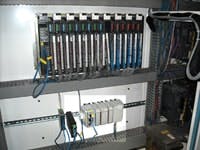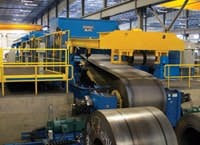Dan Hebert is a former senior technical editor for Control, Control Design and Industrial Networking.
If you work for a machine or robot builder OEM, or if you're a manufacturer with machines and/or robots in your facility, then the subject of automation system obsolescence will arise sooner or later. When it does, you have three options.
One is to rip and replace the entire existing automation system with a new one, an option covered in detail in our June 2013 Control Design cover story "Old Machine, New Life" and touched on in this article. This is the highest-cost option with the most downtime, but the result is a new system that can run for many years.
The second option is to keep the old automation system up and running for as long as possible through a combination of wit, grit and spit. This is the lowest-cost option, but can't be sustained forever, as sooner or later it will become necessary to either rip and replace or retrofit.
The third option is to retrofit part of the automation system with new components, while keeping other parts in place.
Retrofit Advantages
In almost all cases, a retrofit will require less downtime than a rip and replace because the scope of work is greatly reduced. It's also better than a simple "keep running" solution because it replaces the parts of the automation system that cause the most problems.
Also Read: The Pros and Cons of Embedded HMIs For Machine Builders
In many cases, the base machine is fine, but the control system needs upgrading. Georg Transformer in Germany had that problem with a 1981 lamination shear that it builds for transformer manufacturers. The machine had an ancient 486 PC for the controller. Georg found an upgrade path that let the original I/O work with a new controller in an almost plug-and-play project. (See the sidebar, "Save the Old I/O," p. 26 for more on this retrofit.)
Another reason to retrofit arises when support has disappeared for the original control system. Michael Lindley, vice president at Concept Systems, a system integrator in Albany, Oregon, first got involved with an aerospace company 12 years ago, when the company that installed and supported a rivet inspection control system went out of business. "We first duplicated the controls, supported them through the life of the system, then re-programmed the machine with all new hardware, but with the identical look and feel," Lindley explains.
The Automate Co. in Pacific, Missouri, is a system integrator that’s been building machine control systems since 1997. Barrett Davis, principal at Automate, says “I am aware of no one that’s still manufactures, sells and supports I/O hardware that was being built in the early ’80s. We have multiple customers for which I provided upgrades to existing machine control systems without having to replace the original I/O or field wiring.” he says. His company is currently upgrading a lamination shear at Georg Transformer that cuts laminations to size and shape. Read more.
The inspection system checks each rivet just before it's inserted into the wing skin and crushed to make sure it's the right rivet, is not upside down and is oriented precisely vertically. It communicates directly with the CNC system, and uses a pair of orthogonal cameras (cameras oriented so that one sees a front view and the other a side view) with custom backlights.
"We installed the first system with Visual Basic 6 and Windows XP," Lindley says. "The new system uses Visual Studio 2012 and Windows 7/64. We increased the resolution with the third-generation system, although the accuracy of the previous system was adequate."
Upgrading because of Windows operating system problems is a major reason for retrofits. Support for Windows XP ended in April 2014, affecting thousands of PC installations.
One force driving the switch to Windows 7 is the old age of the PCs that run Windows 2000, Windows XP and older operating systems. We often hear that when the old PC dies and must be replaced, users with control and HMI systems that are working OK are forced to make major changes. This raises another problem, Tom Edwards, Opto 22 engineer, observes: "The mandatory shift to Windows 7 and Windows 8 on all of the available newer PCs makes a change in control and HMI software a necessity, as very few of the fundamental I/O functions remain the same or are upgradeable to Windows 7 or Windows 8."
Picking on PLCs
Brains Brewery in Cardiff, Wales, was developing an increasing variety of beers, so it wanted to upgrade its yeast-handling control system to accommodate the new mixes. "The main aim of the project was to upgrade two Allen-Bradley PLC 2 controllers, which were 27 years old," says Mike Cooper of IAC Engineering (www.iaceng.com), a system integrator in Cross Hands, U.K. "Limited downtime was available—only three days—so the six old 1771 remote I/O racks were retained, but the obsolete controllers were replaced by a CompactLogix PLC."
Figure 1: Brains Brewery in the U.K. replaced two 27-year-old PLCs with a new PLC, retaining the original I/O and field wiring and linking the controller and the I/O with a gateway
The connection between the 1771 I/O racks and the CompactLogix (Figure 1) was accomplished with a remote I/O-to-Ethernet migration gateway from ProSoft Technology. "Without the gateway, a more expensive system would have been required. This solution reduced the project cost by 40%," Cooper notes. "Commissioning time was reduced because the remote I/O cards and wiring could be retained. Only the processor and software needed to be added and commissioned, not the field wiring." and wiring could be retained. Only the processor and software needed to be added and commissioned, not the field wiring."
Finding a vendor that's developed a nice piece of hardware or software designed for retrofits can solve a lot of problems. At PARI Pharma, a medical device manufacturer in Germany, a control system retrofit project connected a Siemens S7 PLC to modern databases. (See the sidebar, "Upgrading Connectivity," on p.30.)
Keep ‘Em Running
The eFlow nebulizer, developed by Pari Pharma (www.pari.com) in Gräfelfing, Germany, has been used to treat cystic fibrosis patients for many years. The company is currently installing software to optimize automation of its production equipment, particularly through connectivity improvements. Read more.
But when times are tight and the existing machine or robot is near the end of its useful life, keeping the automation system running by hook or crook can be the way to go.
Some companies put off upgrades until they absolutely have to do them. David Perkon, vice president at AeroSpec, a machine builder in Chandler, Arizona, has customers that prowl eBay and the Internet for old parts, employ maintenance people to keep the machines working, and put off upgrading as long as they can. "Keeping legacy equipment running without replacing the hardware or software is a nice dream until something fails, and you've used your last spare," he says.
One of his customers kept an old machine running for years, until it started having quality and production problems. An analysis revealed that the machine was fine, but the control system needed an upgrade. (See the sidebar, "Time to Upgrade," p. 28.)
AeroSpec in Chandler, Arizona, designs and builds a variety of custom automated equipment for the medical, semiconductor, automotive and defense industries. David Perkon, vice president, says he’s seen many problems with legacy control systems. “It’s not uncommon to have firmware and software driver issues with legacy hardware and software,” he says. “Working with a dated operating system or updating the operating system can cause issues with I/O drivers, application software and PC-based operator interfaces. A programmable controller’s firmware might not be compatible with rack-mounted motion control cards and other smart modules.” Read more.
Because old PLCs are so reliable, it's often difficult to justify a retrofit. Intelligrated, an OEM of material handling systems in Mason, Ohio, supports its older systems, such as Alvey palletizers. "We actively support several customers who have the original PLC 2 1772 series processor," says Chris Hutson, Intelligrated's manager of product support engineering. "Although these machines were manufactured beginning in the mid-1980s, we continue to modify their PLC logic to incorporate new product patterns. Also, we provide troubleshooting for these processors, which have been discontinued by the manufacturer."
Some of their other machines over 30 years old have Modicon PLCs programmed with DOS-based PCs and manual switch panels instead of modern, touchscreen technology. "In many cases, this requires us to read 5¼-in. floppy drives to obtain old machine program files and information from original drawings."
Machine builders appear to be better at keeping legacy systems running than some vendors of control systems. The Bradbury Group, a builder of metal-processing equpment (Figure 2) in Moundridge, Kansas, for example, keeps its customers' legacy equipment running by carrying backups of all the programs that operate the equipment they manufacture.
"Issues often arise when we have to support third-party equipment," says Dennis Clark, Bradbury's project software engineer. "Sometimes it's the proprietary software they provide; other times the equipment vendor might go out of business."
Bradbury builds coil processing and roll forming machines, designed for a life of 20 to 30 years. "The manufacturing lifecycle of the average electrical component is seven to 12 years," Clark notes, "but for PC-based products such as HMIs, it can be as short as three to five years."
Figure 2: This Bradbury coil processing line uncoils, levels, cuts to length and automatically stacks orders. The machines are designed for a life of 20 to 30 years. The company keeps its customers’ legacy equipment running by carrying backups of all the programs that operate the equipment they manufacture.
Some vendors do their best to support older automation systems. "While no one can completely eliminate the risk associated with legacy operating systems, some manufacturers have tools and services to maximize the life of legacy equipment and minimize risk," explains Lonnie Morris, senior manager at Rockwell Automation "Lifecycle extension services from companies like Rockwell Automation provide service options to fit each company's individual needs."
Rip and Replace Has Its Place
Although retrofit or keep running have advantages in many scenarios, that's not always the case, as sometimes it's just better rip and replace.
"We encourage our customers to migrate from obsolete systems to current, actively supported software and hardware platforms," Intelligrated's Hutson notes. "For a soft drink company and other beverage facilities, we converted our high-speed 920 series palletizers from obsolete PLC processors to modern automation based on the ControlLogix platform. On several projects, we lowered the customer's total cost of ownership, met operational compliance regulations, and increased flexibility and performance."
Much of the time, the actual machine itself is reliable, but the control system is causing problems. For example, one of Delta Computer Systems' customers that manufactures automotive components ran into a problem with servo-controlled lathes in its facility.
1. Less downtime
2. Lower cost
3. Less required design effort
4. Reuse of existing cabinets and wiring
5. Reuse of existing I/O, HMI and/or other components
6. Fewer potential problems during commissioning and start-up
7. Reduced risk
8. Less required training
9. Fewer new spares need to be stocked
10. Better compatibility with legacy software
"The lathes were well-designed precision machines, but the servo control system was the original analog design approaching 22 years of age," explains Bill Savela, marketing manager at Delta. "While the machine still produced excellent parts, the downtime associated with the servo-control system was becoming an issue. We determined that the primary problem was the lack of reliability of the old analog control system, and they decided to replace it with a Delta servo motion controller."
And sometimes a retrofit or upgrade isn't enough. "Whether it's old software talking to new devices or new software talking to old devices, a pop-up message warning of a compatibility issue is common," notes AeroSpec's Perkon. When these and other types of compatibility issues arise between old and new systems, sometimes the entire control system has to be replaced.







